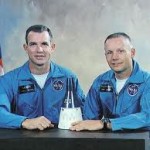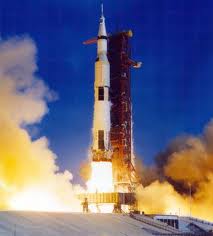Very few people realize or remember that Neil Armstrong came within minutes of dying in space in an out-of-control spacecraft on a space mission before Apollo11. His quick thinking and actions saved him and his fellow astronaut from burning up on an un-controlled re-entry from space.
In March 1966, Gemini 8 mission with Neil Armstrong and David Scott conducted the first docking of two spacecraft in orbit, but suffered the first critical in-space system failure of a U.S. spacecraft which threatened the lives of the astronauts and required immediate abort of the mission. The crew was returned to Earth safely. The only other time this happened was on the flight of Apollo 13, which was years later.
The following is an official NASA Account of the Mission from On the Shoulders of Titans: A History of Project Gemini, by Barton C. Hacker and Charles C. Alexander, Published as NASA Special Publication-4203 in the NASA History Series, 1977.
The Atlas-Agena target vehicle for the Gemini VIII mission was successfully launched from KSC Launch Complex 14 at 10 a.m. EST March 16. The Gemini VIII spacecraft followed from Launch Complex 19 at 11:41 a.m., with command pilot Neil A. Armstrong and pilot David R. Scott aboard. The spacecraft and its target vehicle rendezvoused and docked, with docking confirmed 6 hours 33 minutes after the spacecraft was launched.
This first successful docking with an Agena target vehicle was followed by a major space emergency. About 27 minutes later the spacecraft-Agena combination encountered unexpected roll and yaw motion. A stuck thruster on Gemini put the docked assembly into a wild high speed gyration. Near structural limits and blackout, Armstrong undocked, figuring the problem was in the Agena, which only made it worse. The problem arose again and when the yaw and roll rates became too high the crew shut the main Gemini reaction control system down and activated and used both rings of the reentry control system to reduce the spacecraft rates to zero. This used 75% of that system’s fuel.
Although the crew wanted to press on with the mission and Scott’s planned space walk, ground control ordered an emergency splashdown in the western Pacific during the seventh revolution. The spacecraft landed at 10:23 p.m. EST March 16 and Armstrong and Scott were picked up by the destroyer U.S.S. Mason at 1:37 a.m. EST March 17. Although the flight was cut short by the incident, one of the primary objectives – rendezvous and docking (the first docking of two spacecraft in orbital flight) – was accomplished.
This was not the only time that Neil Armstrong narrowly escaped death while working in the space program. He escaped again while training in a Lunar Landing Research Vehicle that crashed on May 6, 1969. That was just over 2 months before his successful landing on the moon.
Of course, at the time it was important for NASA to put a civilian like Armstrong into a prominent astronaut assignment. Apparently his actions of narrowly escaping death promoted Neil Armstrong to the front of the line of several highly qualified candidates to be the first to land on the moon. NASA wanted someone tested under fire in a real space mission that could use those skills again to save Apollo 11 if required.
A famous quote from NASA is “Failure is not an option”, but as Neil Armstrong demonstrated, failure can be overcome and may lead directly to even better experiences.

